From the RAMAKRISHNA MATH CHENNAI WEBhttp://www.sriramakrishnamath.org/whatitis/belurmath.shtml

The origination of the emblem of the Ramakrishna Order
Ramakrishna Math and Ramakrishna Mission
Headquarters : Belur, Dt. Howrah, Howrah – 711 202
Introduction
If Indian civilization has endured so long, it is only because of the tremendous vitality of the Hindu religion supporting it. And the vitality of the Hindu religion has been maintained by a continual process of self-renewal. The quickening impulse for the rejuvenation of religion comes from a divine source. When virtue declines and evil prospers, a special manifestation of God known as the Avatar appears and starts the rejuvenation process. The accumulated dirt and debris of outmoded customs and ideas are cleared, hidden sources of power are tapped and a new vitality flows into the old religion.
As in the past, in the 19th century there came such a renewal, and the result was ‘for the first time in the history of India an order of monks found themselves banded together.’ And this is the Ramakrishna Order, widely known as Ramakrishna Math and Ramakrishna Mission, initiated by Sri Ramakrishna, nurtured by Sri Sarada Devi, and propagated by Swami Vivekananda.
Origin
During the last days of Sri Ramakrishna his disciples gathered around him. Among them were a few young men specially trained by him to take to the life of renunciation and service, and continue the spiritual ministry that he initiated. Among these young men the most talented was Narendranath who came to be known as Swami Vivekananda.
After Sri Ramakrishna’s passing away the young disciples consolidated themselves into an Order under the leadership of Narendranath. They left their hearth and home, and took to the life of renunciation. Their whole time was devoted to the practice of austerities, and the study of scriptures. In spite of their austerities and wanderings throughout India, they never abandoned their sense of being members of an Order brought together by the love of Sri Ramakrishna and the sense of a mission that he had transmitted to them. The centre of their rallying was the shrine where they preserved Sri Ramakrishna’s relics and carried on his service in a small rented house at Baranagore in Calcutta. This became the first centre of the Ramakrishna Order.
The Order received its definite shape, both in its form and function, after Narendranath emerged as a world figure, under the name of Swami Vivekananda, from the great Parliament of Religions held at Chicago in 1893. His ideas about Sri Ramakrishna’s mission had by that time become clear. He now recognized in the group of his sannyasin brother disciples, whom Sri Ramakrishna had commissioned to be formed into an Order, the nucleus of the spiritual organization for working out the mission of the Great Master. The place where the relics of the Master were preserved had formed the headquarters of this Order, but it was as yet improperly housed, and it was the aspiration of Swami Vivekananda even before he left for the West to build a permanent centre for the Order to house the relics and to carry on its mission.
While Swami Vivekananda was feeling the urge to organize his fellow-monks into an Order, an identical resolution was being formed in the mind of Sri Sarada Devi, the consort of Sri Ramakrishna. In a talk with a disciple, she once said that she used to pray so that the disciples of Sri Ramakrishna may live together and people afflicted with the sufferings of the world should come to them and get peace of mind by hearing from them His words.
This desire of Swami Vivekananda and Mother was fulfilled when Swami Vivekananda was able to purchase a large piece of land on the bank of the Ganga and build the Belur Math with the donation of a Western disciple. But before that, the Order functioned at Alambazar and at Neelambar Babu’s garden-house at Belur for short periods of time successively.
Now Belur Math is the Headquarters of the world-wide Ramakrishna Math and Ramakrishna Mission.
Ideology
While giving a shape and a habitation for the Order, Swami Vivekananda gave it also a definite ideological background. He states: ‘This Organization is His (Sri Ramakrishna’s) very body, and in the Organization itself He is ever present… He who worships the Organization worships the Lord, and he who disregards the Organization disregards the Lord.’ In the light of this conception the Ramakrishna Order becomes the symbol of Sri Ramakrishna and the medium for the working of his will. Its service thereby becomes the service of him. He attached great importance to work done with this devotional spirit. The work done in the Order is only a service of God through the living social symbol.
This devoted work has always to go hand in hand with ardent meditation and deep self-analysis, without which work, however vast it might be in extent and in worldly values, ceases to have any spiritual significance.
Centres
The work in the Order ranges from the running of small monastic centres to the management of big publishing houses, of colleges and other educational institutions, of workshops and engineering institutions, of big hospitals and invalids’ homes, of huge relief operations in famine and flood stricken areas, and so on. Side by side there is considerable preaching work, involving the production of books and periodicals, lecturing to audiences of learned and cultured persons as well as common people, and organizing and leading Vedanta Centres abroad in Asia, Europe, America and Russia.
Besides the Headquarters and 30 subcentres the Order’s Centres are distributed as follows :-
In India
Andaman 1, Andhra Pradesh 4, Arunachal Pradesh 3, Assam 3, Bihar 2, Chandigarh 1, Chattisgarh 2, Delhi 1, Gujarat 3, Jharkhand 5, Jammu & Kashmir 1, Karnataka 6, Kerala 8, Madhyapradesh 1, Maharashtra 3, Meghalaya 2, Orissa 3, Rajasthan 2, Tamilnadu 13, Tripura 1, Uttar Pradesh 6, Uttaranchal 5, West Bengal 35.
Outside India
USA 12, Bangladesh 10 and 1 each in Argentina, Australia, Brazil, Canada, Fiji Islands, France, Japan, Malaysia, Mauritius, Netherlands, Russia, Singapore, Sri Lanka, Switzerland, United Kingdom, Zambia.
| Activities |
1. Spiritual and Cultural
Dissemination of spiritual and cultural ideas is part and parcel of the ideology of the Order. Our centres are real points of contact for people of different faiths through ritualistic worship, festivals, public celebrations, meetings, classes, and personal interviews.
2. Publication
The Order publishes spiritual, religious and cultural literature in English, Bengali, Hindi, Marathi, Tamil, Telugu, Kannada, Malayalam, Gujarati, Sanskrit, and also in some European languages. There are also 13 magazines published regularly by the Order.
The vast body of Ramakrishna-Vivekananda literature and scriptural translations which the Order has produced has become an integral part of the literature of modern renaissance in India.
3. Medical
- Indoor hospitals : 14
- Outdoor dispensaries : 100
- Mobile dispensaries : 39
Besides these, occasional camps are conducted for the treatment of eyes, dental ailments etc.
4. Educational
- Formal Education Centres : 327
- Non-formal Education Centres : 222
5. Relief and Rehabilitation Work
The Ramakrishna Order is always in the forefront in rendering help during natural calamities like flood, cyclone, earthquake, drought, fire etc.
6. Activities for Youngsters
Most of our centres conduct special programmes for youth. Here the youth listen to discourses on spiritual matters, take part in discussions on social problems, and strengthen their own inner potential. They are helped to build their character and become responsible citizens.
Swami Vivekananda’s Call to the Youth
The monastic Order in the name of Sri Ramakrishna is the great gift that Swami Vivekananda offered to the spiritually inclined youth of the world. Such is the training imparted that every successful member of the Order is expected to combine in himself many-sided abilities. He must have the capacity of an efficient civil servant, the erudition and expressiveness of a learned professor, the sociability and attractiveness of a genuine humanitarian, and above all the spirit of renunciation, devotion and serenity of a true lover of God.
Swami Vivekananda himself, and his great brother disciples have by their life of austerity, service and mutual concord generated a holy tradition and kindled the spirit of brotherhood. Those pioneers are all now gone, leaving this great legacy to posterity through their own disciples, and thus the Order and tradition are to be transmitted to generations yet to come for the spiritual upliftment of the world.
Swami Vivekananda knew that an increasing number of young men would eventually join the Order. He wanted these young, energetic souls to have an innate urge for God-realization, combined with intense spirit of renunciation and service. One can join in any of the centres of Ramakrishna Math and Ramakrishna Mission in India or abroad. The new entrant is given a long period of nine years to prepare himself and to examine his own fitness for monastic life before he is made a full-fledged member of the Order.
| Further Reading |

A panoramic view of the headquarters from the river Ganga
![]()
History of the New York Vedanta Society
The Vedanta Society of New York was the first Vedanta Society in the West.
It was established by Swami Vivekananda.
Swami Vivekananda came to NY in the first week of April, 1894, where he had been invited by a group of friends—Mrs. Arthur Smith, Dr. and Mrs. Egbert Guernsey, and Miss Helen Gould. It was from here that he began his “parlor lectures” in the homes of the rich.
After a visit to Boston during the second and third week of April, he returned to New York and on April 24, at the Waldorf Hotel, he gave his first lecture in NY on “India and Hinduism” before Mrs. Arthur Smith’s “Conversation Circle”.
On May 2 at the home of Miss Mary Phillips, at 19 West 38th Swamiji gave his second lecture in New York . Miss Phillips, who attended his lecture at the Waldorf Astoria, went on to become one of his “eager workers” and later offered him her hospitality and help. Her home became a sort of headquarters for his work in New York .
Among those who attended Swamiji’s first lectures were Miss Emma Thursby, the well known singer who became a member of the New York Vedanta Society, and Leon Landsberg, who was to become one of Vivekananda’s first monastic disciples in the West.
On May 6,1894, Vivekananda left New York for Boston . Towards the end of July, he came to the Greenacre Conference in Maine . In Greenacre he met Dr. Lewis G. Janes, President of the Brooklyn Ethical Association who became a devoted friend.
Vivekananda left the Boston area in October and after a tour of Baltimore and Washington, arrived back at New York around November 3 or 4th.
By the end of November he started the Vedanta Society, an informal, group without registration. It served as a means for managing his financial needs. In time the Society became concerned with the religious and philosophical aspects of the work and assisted in the publication of his works.
Following a visit to Boston during December, Vivekananda returned to New York on December 28, 1894 as a guest of the Brooklyn Ethical Society. At the Pouch Mansion in Brooklyn , he gave his first of several lectures for the Ethical Society on December 30, 1894.
Within a few weeks, assisted by Leon Landsberg, Vivekananda established his first headquarters in America in two rented rooms at 54 West Thirty-Third Street . There he held regular classes starting Sunday, January 27,1895.. Among Vivekananda’s first few students were Miss Sarah Ellen Waldo who became one of his disciples and editor of some of his works. Miss Josephine MacLeod and her sister Besse Sturges, met him here on January 29th, 1895. Here he also met Mr. Francis H. Leggett, who later married Mrs. Sturges and remained a friend and supporter of Swamiji and the Society.
Vivekananda taught classes in his rooms from January to June 1895 and in June after a visit to Camp Percy with Francis Leggett, Mrs Sturges and Miss MacLeod, he went to Miss Elizabeth Dutcher’s summer cottage at Thousand Island Park on the St. Lawrence River and taught 12 of his disciples who came mostly from his NY classes .
He returned to New York on August 7,1895 and stayed at the home of Miss Mary A. Phillips at 19 West 38th Street . From New York he left shortly afterward for France and then to England , then returned to New York on December 6,1895.
Swami Kripananda and The Vedanta Society then rented rooms at a lodging house at 228 West 39th Street . There the Swami also lived when he returned to NY. This was the same house where Landsberg stayed for a few months earlier in the year. It was also where, during Vivekananda’s stay in England , Kripananda held classes in November under the auspices of the Vedanta Society.
Vivekananda resumed his classes, twice daily, four days a week, and a question-and-answer class on Sundays.
In December, 1895, Josiah J. Goodwin was enagaged as a stenographer and, as Vivekananda delivered discourses on the four Yogas in his classes—Bhakti, Jnana, Karma, and Raja—they were recorded by Goodwin and later published by the Vedanta Society and others as his now-famous Yoga books.
From December 9, 1895 through February 25, 1896 Vivekananda delivered seventy classes and ten public lectures – much of these being incorporated into his Yoga books.
Vivekananda delivered his final lecture in New York on February 23, 1896, and, under the auspices of his Vedanta Society.
Vivekananda, accompanied by Goodwin went to Detroit on March 3, 1896. After a visit to Boston and Chicago , he returned to New York on April 11 and left America for his second visit to England on April 15, 1896.
During his visit to England the previous year, Vivekananda had asked Sharat, (Swami Saradananda) to come to England and he came and spent some time with Vivekananda in England . With Goodwin, Saradananda came to America and continued the American work. He arrived in New York the first week of July, 1896, and was brought by Goodwin to Boston as a guest of Mrs. Bull.
In summer, the activities shifted from NY to the Greenacre Conference in Maine and on July 7th, 1896, Swami Saradananda delivered his first lecture in America He then lived in Cambridge at the home of Mrs. Bull.
In October, 1896, Swami Saradananda delivered his first lecture in New York before the Brooklyn Ethical Association and began classes in New York in his room at 509 Fifth Avenue , above Forty-Second Street . When the room over-flowed, the landlord allowed the class to move to a ground floor hall—the New Century hall—where the Swami held Sunday morning lectures. He was delivering six lectures a week and traveled and taught between New York , Greenacre, and Cambridge .
As Saradananda prepared to return to India to assist Vivekananda who was in India, Swami Abhedananda arrived in NY in August 1897, and assumed the leadership of the Vedanta Society.
After his arrival in New York Swami Abhedananda began classes.
On February 21, 1898, in the premises of their rented Lexington Street address of the Society, the West celebrated the first birthday celebration of Sri Ramakrishna.
Between September 29, 1897 to April 30, 1898, Abhedananda delivered eighty-six lectures.
Swami Abhedananda incorporated the New York Vedanta Society under the laws of the State of New York on October 28, 1898. Mr. Francis Leggett became the President of the Society on its formal registration.
Abhedananda lived and held classes in rented houses and apartments, and for public lectures rented bigger halls in the city.
Meanwhile Vivekananda returned to America on August 28, 1899, with Swami Turiyananda. On arriving in New York , he proceeded to Ridgely Manor, as the guest of Mr. and Mrs. Leggett. He came to New York from Ridgely on November 7, 1899.
The Vedanta Society occupied a parlor floor of a narrow, four-story house at 146 East Fifty-Fifth Street (between Lexington and Third Avenues) and was the first permanent Vedanta Headquarters in New York .
Opened on October 15, 1899, this Center had a library, weekday lectures, classes and private interviews were held regularly, and had a regular meditation hour.
For the Sunday lectures, where attendance numbered around three hundred, Swami Abhedananda lectured in a rented public hall.
Vivekananda stayed in New York for two weeks, residing at the New York residence of the Leggetts and Dr. Guernsey. He often came to the Society’s headquarters; held question-and-answer classes at the regular weekly meetings; and came at other times to talk with the students. Two weeks later he went to California .
Swami Turiyananda moved to New Jersey and stayed at MontClair , and assisted Swami Abhedananda at New York , until he was called by Vivekananda to California .
By April, 1900, Swami Abhedananda opened a membership roll for the New York Society. The Society with support from its members was able to rent an entire house for its headquarters. In the spring of 1900 the Society moved from its rooms at 146 East Fifty-Fifth Street to a modest four-story house at 102 East Fifty-Eighth Street , just off Park Avenue . When Swami Vivekananda arrived on June 7,1900, after his trip to the West Coast he stayed at this home.
During this stay at the breakfast table one morning he sketched on the back of an envelope, a design of an emblem that was to become the official seal of the Ramakrishna Order.
On July 26, 1900, he left the west for the last time and returned to Europe and finally to India .
By 1901, Swami Abhedananda audiences for lectures were as many as six hundred. In addition he held classes on Raja Yoga and other subjects. From 1902 onward, he began to pay occasional visits to England and Europe . In April, 1905, the Society began publication of the Vedanta Monthly Bulletin. At the time, the address of the Society was listed as 62 West 71st. Street. By 1906 the books and pamphlets published by the New York Vedanta Society reached 50,000.
Another assistant was needed and Swami Brahmananda sent Swami Nirmalananda who arrived in New York on November 25, 1903. A Vedanta Center was opened in Brooklyn on January 30, 1905 under Nirmalananda and he lived there without much success until called back to India in January, 1906. A second short-lived Center was opened in Washington , D.C. in early 1905 following a visit by Abhedananda.
In April 1906, Swami Bodhananda, a disciple of Swami Vivekananda, arrived as assistant to continue the work in New York , as Swami Abhedananda left for a trip to India , the first since he had left India in September of 1896.
Swami Abhedananda returned to America in November, 1906, accompanied by another of Vivekananda’s disciples Swami Paramananda.
On March 2, 1907 the Vedanta Society of New York acquired with a loan its first permanent home at 135 West Eightieth Street . Swami Abhedananda also purchased a 370 acre farm-house in Berkshire Connecticut to serve as a retreat for Vedanta students. In January a Center was established in Pittsburgh. Swami Bodhananda left New York to take charge of the new Center.
Abhedananda’s approach contrasted with Swami Paramananda’s traditional “Master-Disciple” attitude. In 1909, Swami Paramananda left New York to take charge of a new honourary that started in Boston .
During an extended tour in Europe by Abhedananda, the financial base of the Society declined, the principal cause being a fall in attendance following the Swami’s absence. Abhedananda’s growing role as world teacher, following his success in Europe and America , began to come in conflict with the immediate demands of the NY Society and its membership.
In May, 1910, Swami Abhedananda left the New York Society permanently. The membership had fallen (from 200 in 1906 to 50 by 1926). It could not make the payments on the loan based on contributions and The Society rented out most of the rooms in the building to pay the mortgage.
Swami Bodhananda closed down the Pittsburgh honourary in October of 1912 and returned to take charge of the New York Society. For forty years, thereafter Swami Bodhananda, assisted periodically by younger Swamis sent from India , sustained the society. He was the first Indian monk of the second generation to take charge of the Society.
The Vedanta Society ultimately gave up the Eightieth Street home of the Society in June 1915. And moved to 236 Central Park West. From here, Swami Bodhananda focused on re-building the Society with a small, committed group of devotees.
In 1921, through a gift from one of his students, Miss Mary Morton, daughter of Levi P. Morton, ex-Governor of New York and Vice President of the United States during the term of President Benjamin Harrison (1888-1892), the Vedanta Society purchased outright a house a half a block from Central Park . With ample space for an auditorium and a new chapel, the Vedanta Society of New York moved to its present location at 34 West Seventy First Street .
Over time, the Vedanta Society provided one of the first complete libraries of Hinduism and Vedanta literature in America , it served as a major library and publication house of Vedanta literature in the West, and the headquarters of Vedanta as a global movement, to both America and Europe .
It also served as a training ground for new Indian Swamis sent to serve as monastic leaders to the West. The New York Vedanta Society received a number of young Swamis from India , who after an initial period of training through assisting Swami Bodhananda, went to other parts of the country to establish and expand the mission of Vedanta.
Swami Raghavananda arrived in June, 1923 and assisted Bodhananda, while at the same time developing Vedanta in Philadelphia . Ill health forced him to return to India in 1927. Swami Gnaneshwarananda, a disciple of Swami Brahmananda, came to New York in 1927. After two years, he left for Chicago where he was to start a new Vedanta Center . Also in 1927, Swami Bodhananda, on the request of Swami Paramananda, found time to nurse and take care of the young Swami Akhilananda, whose health had deteriorated while in Boston . In the meantime, Swami Devatmananda who had arrived at New York worked in NY until 1932 when he moved to the West coast to work at the Portland Center .
In 1931 Swami Nikhilananda, a disciple of the “Holy Mother,” who had received his monastic vows from Swami Saradananda, arrived and Bodhananda decided to hand over to him the leadership role of the NY society and retire. Swami Nikhilananda style conflicted with Swami Bodhananda’s ideas and Bodhananda came out of retirement and resumed leadership. Swami Nikhilananda meantime was induced by his own following of devotees to start his own Center in New York . He founded the Ramakrishna-Vivekananda Centre in 1933 at 200 West Fifty Seventh Street which later moved to its present location off Fifth Avenue in 1939.
Meanwhile, the Vedanta movement started in California by Vivekananda in San Francisco by the efforts of his brother disciples, Swamis Turiyananda and Trigunatitananda grew as did Centers in Boston , Chicago , Los Angeles , Seattle , St. Louis , and Portland .
In New York , Swami Bodhananda working with a small group of devotees, among whom were the Genêt sisters—Jeanne and Rolande from French-Canada—continued for forty-four years, until he passed away in New York on May 18, 1950.
Swami Pavitrananda arrived in New York in February, 1951, to assume charge of the Society. Preceding his arrival, for a brief period the classes of the Society were maintained under the President Abraham Reiger and Secretary Delia Stebbins. Swami Pavitrananda served as spiritual leader of the Vedanta Society of New York for twenty-six years until he passed away following an extended illness at age 81 on November 18,1977.
He continued the traditions of the past fifty years since Vedanta had first come to America . There was a regular schedule of Sunday public lectures, Tuesday night general classes with question-and-answer periods, and other evenings of library sessions, the latter primarily for the members. Swami Pavitrananda was also a member of the governing body of the Ramakrishna Mission—the Executive Board of the organization. Among his books are “Common Sense About Yoga” and “Modem Man in Search of Religion”.
When Swami Pavitrananda began his work, membership hovered around the sixty mark; and the annual budget was in the vicinity of nine or ten thousand dollars, with occasional appeals and fundraising drives for special projects such as improvements to the building, the original chapel in the Society’s building was renovated.
Following the tradition of the Vedanta Center since the time of Swami Abhedananda, the Society continued to celebrate the birth anniversaries of Shri Ramakrishna and Sri Sarada Devi, the Holy Mother. In 1953, the society celebrated the Birth Centenary of the Holy Mother and the meeting was a great success. Swami Pavitrananda accepted invitations to address groups outside of the Vedanta Center such as Colleges, Universities, Churches, and other institutions involved and interested in the study of Vedanta.
In 1962, the Center started a new tradition, the celebration of the life and works of Swami Vivekananda on the Fourth of July held every year at Moss Hill Farms in upstate New York .
In 1971, through the Swami’s initiative and Courtney Olden, a senior office-bearer of the Vedanta Society, the Society property was placed under legal “church status” as regards exemption from taxes. Swami Pavitrananda was also able to raise money from members of the Society for special projects, such as renovations, rebuilding of the Library, repairs and furnishings of the Society’s rooms, etc.
On November 18,1977, Swami Pavitrananda passed away.
With Swami Pavitrananda’s declining health, Belur Math sent to New York in 1977, Swami Tathagatananda, a disciple of Swami Virajananda—to assist him. After the passing away of Swami Pavitrananda, he served as the monastic leader of the Society.
Books by Swami Tathagatananda:
- The Vedanta Society of New York — A Brief History, 2000
- Mahabharat–Katha (Bengali), 1998
- Ramayan Anudhyan (Bengali), 1996
- Healthy Values of Living, 1996
- Meditation on Swami Vivekananda, 1994
- Meditation on Shri Ramakrishna and Swami Vivekananda, 1993
- Glimpses of Great Lives, 1989
- Shubha Chinta (Bengali), 1988
- Smaran–Manan (Bengali), 1987
Presidents of the Ramakrishna Order
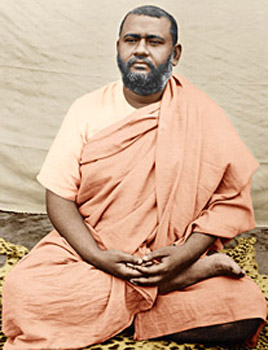
1st President: Swami Brahmananda
b.21 January 1863 – d. 10 April 1922
President from: 1901–1922
Premonastic Name: Rakhal Chandra Ghosh
Place of Birth: Sikra-Kulingram, 36 miles north of Kolkata
Father: Anandamohan Ghosh, a landlord
Mother: Kailashkamini devi
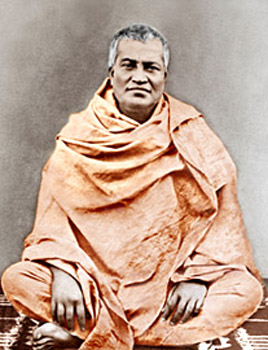
2nd President: Swami Shivananda
b. 16 November 1854 – d. 28 February 1934
President from: 1922 to 1934
Premonastic Name: Taraknath Ghosal
Place of Birth: Barasat, a small town east of Kolkata
Father’s Name: Ramkanai Ghosal (Attorney and devout worshipper of Kali)
Mother’s Name: Vamasundari devi
His astrological horoscope indicated that the child would either be a monk or a king. Taraknath’s did become a monk and later as the second President of the Sangha, ruled over an expanding spiritual empire. Swami Vivekananda gave him the name Mahapurush when he heard that he had, in his youth, completely conquered lust. A spiritual aspirant from his very young age he was born as a result of prayers to Tarakeshwar Shiva and so was named Taraknath. His innate characteristics were that of a Shiva nature.
With his family falling on hard times, he took up a job in Gaziabad and Mugalsarai in North India and then later in Kolkata. He spent his spare time in meditation and prayers and inexorably the intensity increased. This mental inclination finally brought him to Sri Ramakrishna. He was the first to renounce everything and spent his days in Dakshineswar and in a solitary place in Kolkata (Kankurgacchhi), purchased by Ramachandra Dutta at Sri Ramakrishna’s behest.
His spiritual stature even his young age was awesome. After Sri Ramakrishna’s passing away, Mahapurush Maharaj, now Swami Shivananda, meditated and traveled as traditional monks do. He traveled the length and breath of the country without possessions bearing with equanimity: heat and cold, praise and censure, hunger, thirst, etc.
His devotion to Holy Mother and the other gurubhais was as profound as he was. Austere by nature that had broken his once robust health, he had a soft heart and empathized easily. He was very tall with a powerful personality and was a great worker in the Sangha: observant, obedient, silent. Swami Vivekananda had made Swami Shivananda was one of the Trustees of the Sangha and after the passing away of Swami Brahmananada in 1922, was elected President. His very presence was inspiring and till his passing away, despite illnesses, consolidated the work of the Sangha.
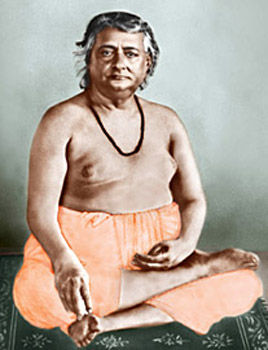
3rd President: Swami Akhandananda
b. 30 September 1864 – d. 7 February 1937
President from: 1934–1937
Premonastic Name: Gangadhar Gangopadhyay
Place of Birth: Ahiritola in west Kolkata
Father’s Name: Srimanta Gangopadhyay (Sanskrit Teacher and spiritual aspirant)
Mother’s Name: Vamasundari Devi
Swami Vivekananda used to call him ‘Ganges’. He was devoted, from his very young age, to the brahmanical traditions of spirituality. Gangadhar came early to Sri Ramakrishna who loved his simplicity and adherence to spirituality, and moulded the boy’s mind into a new and higher direction. Sri Ramakrishna conferred on Gangadhar, during his visits to Dakshineswar, great spiritual insights and visions. Gangadhar was very vivacious and good-looking and loved Swami Vivekananda.
His devotion to the numerous gods and goddesses was great and had memorized many scriptures and hymns even as a boy. His noble parents knowing his pure and strong-willed nature did not serve as obstacles to his quest for God realization.
Monks undertake traveling to form character and to depend solely on God for everthing. Swami Akhandananda, who from an early age was attracted to the Himalayas, was one of the most itinerant monks among the brotherhood and his itinerant experiences in Tibet were thrilling. He was a yogi, who preferred to keep this fact hidden from everyone, preferring to live on a high plane and subjecting his body and mind to great tests of endurance.
He was the first monastic disciple of Sri Ramakrishna to put into practice the new monastic trend of practical Vedanta as propounded by Swami Vivekananda. His field was first Khetri, Rajasthan, and then Sargacchi, West Bengal. The latter look the major portion of his life. He undauntedly devoted himself to the elevation of the sick, poor and uneducated believing implicitly in the universal saving power of Sri Ramakrishna, Holy Mother and Swami Vivekananda. He retained all through, his fearlessness, simplicity and good looks that endeared all to him. He became the third President of the Sangha in 1934 after Swami Shivananda’s mahasamadhi. In his benign presence, everyone young or old, learned or ignorant felt at ease and at home.
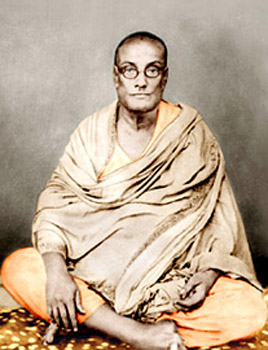
4th President: Swami Vijnanananda
b. 30 October 1866 – d. 25 April 1938
President from: 1937–1938
Premonastic Name: Hariprasanna Chattopadhyay
Birth Place: Etawah, Uttar Pradesh
Father’s Name: Taraknath Chattopadhyay (Commissariat of the British Govt.)
Mother’s Name: Nakuleshwari Devi
This child was passionate for religion and truth. His family had moved to Belgoria, near Dakshineswar, from North India, when he was young. This was truly providential. Sri Ramakrishna said of Hariprasanna that in his previous incarnation he had wrestled with Sri Krishna. On one of his visits asked this strong, tall, young boy if he could wrestle and himself stood up ready to grapple. At Sri Ramakrishna’s touch Hariprasaanna felt his strength ebbing and waves of bliss engulfing him.
Peshon, as he was named by Swami Vivekananda was a brilliant student and later became an engineer. His father having died, Hariprasanna became the breadwinner for his family. He discharged this duty well till the family were no longer in dire straits and then in 1896, came and joined the Sangha after Swami Vivekananda returned from the West. He was the last direct disciple to take sannyasa.
Swami Vijnanananda was responsible not only for many projects for the Indian Railways but also the renovation of Belur Math buildings, the Ghat, Sri Ramakrishna Temple, and helped the Varanasi and Kankhal centers with his expertise. Swami Vivekananda sent him to Allahbad to start a centre. Here Vijnananandaji had many spiritual experiences and Swami Brahmananda confirmed him as being a knower of Brahman. He spent most of his monastic life in this holy city, frequently coming to Belur Math. He was reticent, retiring, deeply indrawn and meditative by nature. His habit of wearing clothes was funny. He was a good scholar and translated scriptures and also the Surya Siddhanta. His service to the poor and suffering.
On the passing away of Swami Akhandananda, in 1937, he was elected President. He traveled now as a spiritual dynamo spreading the power and message of his Master, Holy Mother and Swami Vivekananda. He attained mahasamadhi on Sunday 25 April 1938 in an elevated spiritual state in Allahbad.
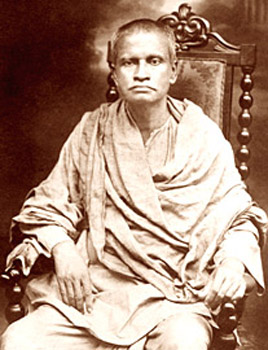
5th President: Swami Shuddhananda
b. 10 October 1872 – d. 23 October 1938
President from: 1938–1938
Premonastic Name: Sudhir Kumar Chakravarty
Place of Birth: Kolkata
Father’s Name: Aushotosh Chakravarty
Mother’s Name: Kusumkumari devi
With the passing away of Sri Ramakrishna’s direct disciples, it was now left to the next generation of monks, mainly the disciples of Swami Vivekananda, to sustain and guide the Sangha. Sudhir had had the privilege of writing down Swami Vivekananda’s Rules for the Sangha when the Math was still temporarily housed in Alambazar. It was also due to his zeal and perseverance that Swami Vivekananda’s many writings and talks were translated into Bengali.
Swami Shuddhananda’s younger brother Swami Prakashananda had joined the Sangha before him. Swami Shuddhananda’s life was a living commentary on the life and message of Swami Vivekananda and was the embodiment of practical Vedanta. An erudite scholar, he manifested the synthesis of the four yogas. He looked on Holy Mother as non-different from Sri Ramakrishna. The direct disciples also received the highest veneration from him. His humility was astonishing and he looked on himself as the servant of the Sangha. His editorship of Udbodhan was marked by insightful writings and made the journal, started by Swami Vivekananda, into a literary fest.
Having being trained by the direct disciples he in turn trained–in thought, word and deed and through scriptural studies–the young novices who flocked to the Ramakrishna ideal. He didn’t have much need for mere travel but spent time in North India and Varanasi practicing austerities, inspiring people with his pure life and his guru’s message.
Swami Shuddhananda was a born leader. One thing that he wasn’t blessed with was good health. He was elected a Vice President in 1937, and on the passing away of Swami Vijnanananda on 18 May 1938, he was made President. His appointment was joyfully received but alas it would be only for six months. Swami Shuddhananda never disappointed anyone monastic or lay and was a strict follower of the Math Rules. He was responsible for streamlining the workings of the Math and Mission.
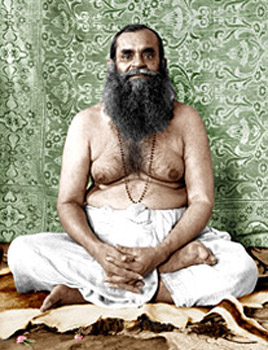
6th President: Swami Virajananda
b. 10 June 1873 – d. 30 May 1951
President from: 1938–1951
Premonastic Name: Kalikrishna Bose
Place of Birth: Kolkata
Father’s Name: Trailokyanath Bose (a renowned physician)
Mother’s Name: Nishadkali devi
Kalikrishna was unique. As a baby did not sleep at night nor let his mother suckle him. Thus he grew and he was greatly helped by his family especially by his extremely devoted mother, to turn towards God. Kalikrishna was unique also because he had Holy Mother as diksha guru and Swami Vivekananda as sannyasa guru. Thus was found in him the fire of Swami Vivekananda coupled with the tenderness of a mother’s heart.
Kalikrishna was fortunate to come across likeminded friends like who later became monks. Water seeks its own level and so with other things. Kalikrishna was introduced to some of the direct disciples of Sri Ramakrishna who were burning fires of spirituality and who were then staying at the Baranagar Math. This enkindled in the young boy the spirit of renunciation and he later joined them permanently. He went to Jayrambati and received Holy Mother’s grace in abundance. Due to ill health, he was asked to return home by Holy Mother and to return when his health had recouped. His pattern of living was astonishing: working and serving others and spending long hours doing japa and meditation. His devotion to Holy Mother was unparalleled and he with all his accomplishments behaved like a child in her presence. Swami Vivekananda ordained and made him Swami Virajananda.
At Swami Vivekananda’s behest and blessings he undertook to propagate the life and message of Sri Ramakrishna not only by lecturing but but also through relief work for the distressed. He was a good scholar and painstakingly compiled Life of Swami Vivekananda and much of the Sangha literature. He was the second head of Advaita Ashrama started by Swami Vivekananda, in the Himalayas. At the sudden passing away of his gurubhai Swami Shuddhananda, in 1938, Swami Virajananda became President of the Sangha till his mahasamadhi in 1951. Swami Virajananda’s tenure was marked by efflorescence in all the activities of the Sangha.
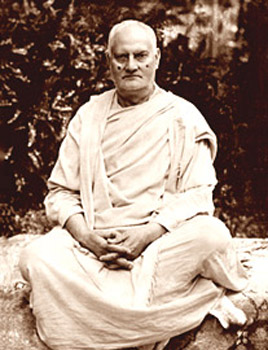
7th President: Swami Shankarananda
b. 9 March 1880 – d. 13 January 1962
President from: 1951–1962
Premonastic Name: Amrita Lal Sengupta (known as Amulya)
Place of Birth: Hooghly, hailing from Bamanmuda, 24 Parganas
Father’s Name: Nabin Krishna Sengupta
Mother’s Name: Satavati devi
The young student gave up a promising medical career after he dropped from Medical College and decided to be a healer of souls instead. Amulya joined the Sangha in 1902 and why not? As a student he heard Swami Vivekananda lecture and awaken the nation. He was also the nephew of Swami Sadananda, Swami Vivekananda’s first disciple. In 1903 he accompanied his uncle and Sister Nivedita to Japan where he stayed for six months, visiting China on his way back. He had the good fortune of meeting many of the direct disciples who inspired him constantly to live a higher life. Initiated by Swami Brahmananda whom he served for some years and had the rare privilege of traveling with him to many centers and pilgrimage places in India. He was also well read in Puranic literature.
He was a doer, good at construction work. Swami Shankarananada supervised the construction of Bhubaneshwar Math in Orissa and Swami Brahmananda’s Temple in Belur Math. He also organized many a relief projects putting his heart and soul to alleviate the pain of the distressed.
He was big, fair and had a deep of voice. His power of observation was phenomenal and nothing escaped him whether gross or subtle. His devotion to Swami Vivekananda was canalized through the work of collecting and preserving a considerable number of his letters. This painstaking work also extended to the letters of other direct disciples of Sri Ramakrishna. He was very austere, having seen hard days at the Math in its early period and was also very strict, self-reliant and attentive to the smallest detail.
In 1947 Swami Shankaranandaji was elected Vice President and on 19 June 1951, elected President after the passing away of Swami Virajanandaji. His short tenure as a spiritual head was awe-inspiring. Swami Shankaranandaji was always wrapped with a profound and silent atmosphere that doctored souls and brought the balm of peace to all.
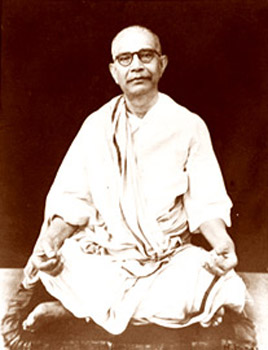
8th President: Swami Vishuddhananda
b. 1882 – d. 16 June 1962
President from: 1962–1962
Premonastic Name: Jitendranath Rai
Place of Birth: Gudap, in Hooghly
Father’s Name: Hemchandra Rai
Mother’s Name: Kiranbala devi
A young boy sat meditating in a village shrine dedicated to the Divine Mother Kali. He was a regular, having learnt devotion to the goddess from his extremely poor, simple and large-hearted mother. One day he experienced consciousness, soaking everything like after heavy rains when everything is soaked. This spiritual experience revolutionized his mind. Later Swami Brahmananda acknowledged that he was a yogabrashta rishi. (one who had just failed to attain the ultimate goal in his previous life).
The extreme poverty of the village that was noted for its hospitality forced him to come to Kolkata. It was here he came across a book on Sri Ramakrishna and this finally settled for him what he wanted to do and become. He was initiated by Holy Mother and was also given the ochre robes in Jayrambati. He along then proceeded to the sacred Varanasi where Swami Shivananda who was then staying there would formally ordain them. He was austere and loving by nature and the close contact with the great disciples of Sri Ramakrishna was a blessing that moulded early his spiritual life. He was sent to Chennai to work under Swami Ramakrishnananda. After a few years he looked after the Bangalore Ashrama. The sprawling Ranchi Ashrama today is due to his hard work. Here he stayed for 25 years. He was made the Vice President and on the passing away of Swami Shankarananda became President in 1962. He passed away the same year.
Swami Vishuddhananda devoutly read the Gospel of Sri Ramakrishna and emphasized its saving power and deep spiritual truths to everyone who came to him. Other than this he was extremely reticent especially about regarding himself. Debilitating health marked his brief tenure but his serene face never gave a hint of trouble.
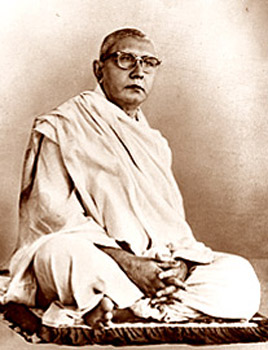
9th President: Swami Madhavananda
b. 15 December 1888–6 October 1965
President from: 1962–1965
Premonastic Name: Nirmal Chandra Basu
Place of Birth: Baganchra, in Nadia District, West Bengal
Father’s Name: Hari Prasad Basu.
Mother’s Name: Binduvasini devi
In a hospital run by the Sangha, Swami Madhavananda lay in his final days. Like a lion that turns his great fearless head to glance behind and then proceeds on his way (simhavalokanam), so did the great soul Swami Madhavanandaji survey all that he ruled with a heart, head and hand before proceeding towards the goal. Holy Mother had paid the best compliment to this child of hers by saying that he was like ivory plated in gold: Spirituality was the ivory and scholarship was the gold embellishment.
Nirmal had graduated from Calcutta University and had come in touch with the direct disciples of Sri Ramakrishna. He was initiated by Holy Mother and ordained a monk by Swami Brahmananda in 1916. His early photos reveal determination and intelligence in a sweet face. His brother too later became a monk (Swami Dayanandaji). Swami Madhvananda worked for some time in the publication sections of Udbodhan and then Advaita Ashrama. He Sanskrit scholarship in the scriptures was deep and he translated some important scriptures into English. He also translated many Swami Vivekananda’s lectures in Hindi. His grandest work was the translation of the Brihadaranyaka Upanishad into English and the Gospel of Sri Ramakrishna into Hindi with the help of a pundit (Nirala).
He was head of Advaita Ashrama then elected a Trustee of the Sangha and in 1927 sent to the US to preach. After two years he was recalled to take up administrative work at the Head Quarters as Assistant Secretary and then as General Secretary in 1938. For more than two decades he administered the Sangha’s work fraught with great difficulties during the massive crises that shook the world during the wars. He was elected Vice President in 1962 and became President in the same year.
Though brusque, he was noted for his saintliness, austerity, straightforwardness, simplicity and devotion to duty and lofty moral standard. Meticulous and patient he showed rare sagacity and tolerance. He commanded spontaneous respect and love from one and all.
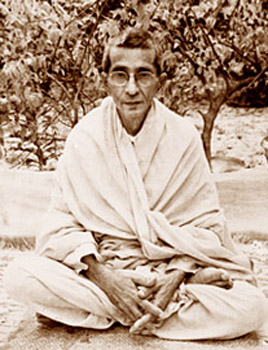
10th President: Swami Vireswarananda
b. 31October 1892 – d. 13 March 1985
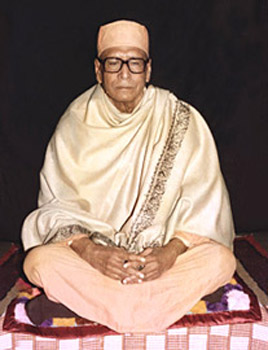
11th President: Swami Gambhirananda
b. 11 February 1899 – d. 27 December 1988
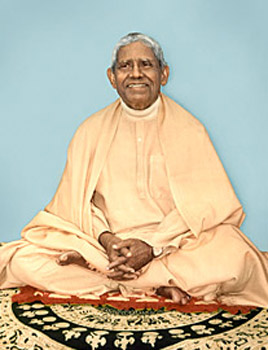
12th President: Swami Bhuteshananda
b. 8 September 1901 – d. 10 August 1998
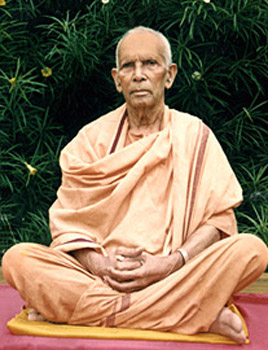
13th President: Swami Ranganathananda
b. 15 December1908 – d. 25 April 2005
President from: 1998–2005
Premonastic Name: Shankaran Kutty
Place of Birth: Trikkur, near Trissur, Kerala
Father’s Name: Neelakantha Shastri
Mother’s Name: Laxmi Kutty Amma
Reading the Gospel of Sri Ramakrishna at fourteen changed his life forever. He had had an earlier mystic dream as a boy which was latter concretized and enacted in Ooty when Swami Shivananda, the then President of the Sangha, initiated him. Later Shankaran also received his novitiate and monastic wows from his guru. Swami Akhandanandaji at Sarcachi blessed him that in the future, he would spread the life and message of the Holy Trio.
Shankaran joined the Mysore centre as a novice in 1926 and worked hard at every type of work, studied hard and meditated hard. His was a life of intense selflessness and inspiration. He had to evacuate from Rangoon (Yagoon) and Karachi during the Japanese advance and partition of India respectively. He worked for the relief of those affected and was also later responsible of building up the Sangha’s Hyderabad branch.
His memory was phenomenal and so was his grasp of Vedanta and every modern branch of secular and scientific learning and he used his oratorical skills effectively to become one of the most prolific speaker and thinker of his time both in the East and the West. His lectures and classes talks were so inspiring that for more than half a century he continued to inspire people of all walks of life, especially in India.
Intellectuals and skeptics never had any chance to even marshal their arguments against him. National, International Governments and Non-Government organizations, Universities and Research institutions, feted and hosted him. In his personal life he always kept the ideal of sannyasa high never possessing anything, having no personal needs. He was elected a Vice President in 1989 and on the passing away Swami Bhuteshanandaji, became the President. His concern for the poor and especially women was remarkable. His life was one practical demonstration of practical Vedanta.
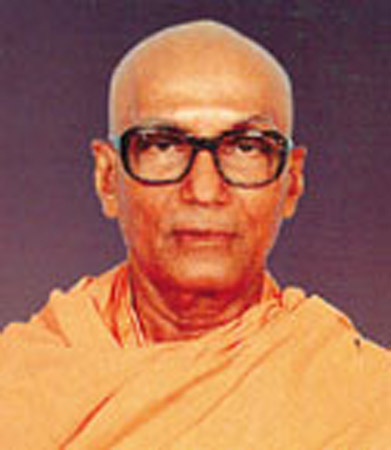
14th President: Swami Gahanananda
b. October 1916 – d. 4 November 2007
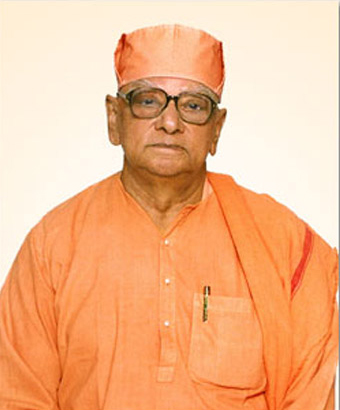
15th President: Swami Atmasthanandaji
b. 1919
Publications of the Ramakrishna order
- Udbodhan Office, is a publishing house for the spread of Ramakrishna-Vivekananda literature, which initially brought out the life and works of Swami Vivekananda and others in article form in the magazine and later on published them as books.
- The Vedanta Kesari is an English monthly, published by Sri Ramakrishna Math, Chennai. Started in the year 1895 the ‘Brahmavadin’ assumed its present name ‘The Vedanta Kesari’ in the year 1914.
- Prabuddha Bharata was started in 1896 under the inspiration of Swami Vivekananda…
http://www.advaitaashrama.org/sitefiles/x_prabuddha_bharata.asp